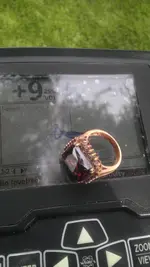The differences are acute. IIRC, the eagle spectrum uses four 'C' cell batteries, which makes for a fairly large control box, and the display on the pod is pretty rudimentary when compared to the V3i's huge color display. Other differences are, of course, three frequencies vs. one.
First, new technologies and closer tolerances in coil manufacturing as well as integrated circuitry has resulted in greater actual depth, that is, the magnetic field being generated is larger and more sensitive to anomalies.
Second, the 6.6 kHz the eagle spectrum operates at is a good compromise, work-horse frequency choice. However, the three frequencies that the V3i operates at are better choices in terms of response to metal.
Third, even though the eagle spectrum has a digital display, it is still an analog detector. It's ground filters are controlled by an analog device. The processors of the V3i compare and correlate millions of bits of data per second to provide you with the best signal response and interpretation possible. It's ground filters are electronic and selectable to suit conditions.
The price is well justified, the V3i is much more capable than the eagle spectrum. However, there is a huge amount to learn and just about none of it transfers over from the spectrum. You may be so comfortable with the spectrum that you don't want to leave it, especially in light of the amount of effort required to truly learn the V3i (if you want to maximize it's capabilities). Don't get me wrong, you can certainly use the canned programs with great success, but if you want the most ROI, then you are going to want to get under the hood and optimize the controls to match the environment you are in.





